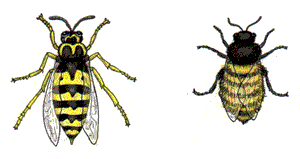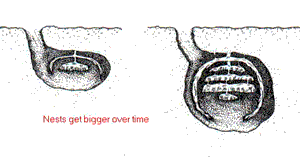Identifying Yellowjackets
Only 6 of the 20 species of yellowjackets and hornets occurring in North America are considered pests. They include the eastern, western and southern yellowjackets, the German yellowjacket, the common yellowjacket and the bald-faced hornet. They are all small yellow-and black-banded wasps, about 1/2 to 3/4 inch long.
 |
| Yellowjacket on left Honeybee on the right |
Like their industrious cousins, honeybees, yellowjackets are social and live in highly organized colonies. To distinguish them from honeybees look at their wings while they are at rest. Yellowjackets lay their wings straight back on either side, exposing the lower body wasp style, whereas honeybees fold their wings neatly atop one another, covering their lower body. Honeybees are also stouter and furrier, and often have little balls of pollen stuck on their hind legs. Yellowjackets eat pollen, but they don’t collect and store it. For their part, honeybees don’t usually forage at picnic tables.
Identifying Yellowjacket Nests
 |
Yellowjackets usually establish their colonies in underground nests, sometimes in old stumps or abandoned rodent holes--often in lawns. Occasionally nests may be inside hollow walls in houses. They are made of a paper-like material called “carton” which yellowjackets manufacture by mixing their saliva with wood they chew to form a pasty pulp. Bald-faced hornets build their football shaped nests aboveground in tree branches, under eaves and similar places.
Yellowjacket nests contain layers of individual cells for eggs and developing larvae, all protected by an exterior carton envelope. Typically they are used only for one season, then abandoned for winter. Destroy them then, not in late summer or early fall when the insects are most aggressive.
Yellowjacket Growth Stages
The fertile female yellowjacket queen is the only member of the previous year’s colony to winterover. She emerges from hibernation in the spring (late March to May) and begins nest-building. She lays about 50 to 70 eggs and then handles all duties until the first group of larvae hatch and matures into workers. Once they take over nest-building and feeding new larvae, the queen only lays eggs.
Workers enlarge the nest and supply partially chewed insects and various caterpillars to the developing larvae which reward them with a sugary food substance. The larvae increase in numbers until midsummer as the colony builds to up to 5,000 members. Then the population declines as the weather gets colder, finally dying out for the winter. Surviving queens mate and

